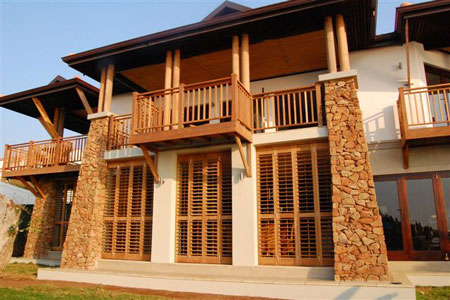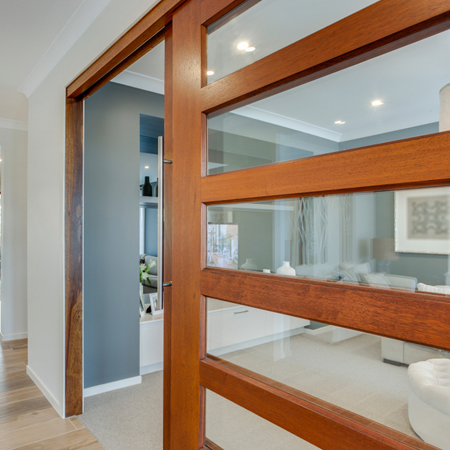Care for Wooden Windows and Doors
There is a beauty to timber windows and if they are well maintained, they can last a lifetime.
16/05/2022
Charl Jacobz from Swartland offers some tips and advice on how to best maintain the beauty of wooden window frames and doors.
Wooden windows and doors require periodic care to ensure they maintain their good looks, durability and proper function. Naturally, timber windows are subject to a mixture of weather conditions and due to the various types of architectural and installation solutions, there is no hard and fast rule that stipulates just how often these maintenance activities should be done.
However, Charl says that the more regularly the maintenance is carried out, the better: "Periodic checks and maintenance need not be a very time-consuming and laborious job, and if done regularly, it can head off any potential problems before they have begun or in the early stages. This will no doubt save you lots of time, effort, and money in the long run. In South Africa, special attention should be given particularly to those wooden windows that are located on northern and western elevations, where the sun’s UV rays are most harsh."
Charl notes that preventative treatment is essential to avoid any severe damage in the future: "A good habit is to inspect, clean and do the necessary maintenance that is required, every six or so months."
Cleaning
Over time, a build-up of dirt, soot and other harmful contaminants will accumulate on any exterior window, which can be exceptionally damaging if it is not periodically washed off. Charl explains: "Typically, dirt and soot are acidic and over time they can seriously damage any timber window’s finish and in the process, the actual wood." As such, he recommends that any wooden windows should be thoroughly cleaned, both inside and out, twice a year. Here’s how:
- Wipe down the surface with a dust-free, damp cloth or sponge.
- If the dirt and soot build-up is excessive, you can wash it off using a dust-free cloth or sponge and a light mixture of warm soapy water. The best detergent should be mild, have a neutral PH, and it must be non-abrasive.
- Rinse off the surface with plain water to remove any soapy residue, and let the surface dry out completely.
Checklist of possible problems
According to htrwindows.ca, while cleaning the windows, it is a good time to closely inspect them for any possible problems, which could include:
• Water penetration: This can be caused by cracking of the wood finish due to lack of necessary maintenance, or due to lack of general house maintenance, such as a leaky drainpipe or gutter, rising damp, and so on. Timber windows are designed to withstand water, as long as it clears away without lingering – if the water is consistently in contact with the wooden window frame, this will eventually lead to damage.
• Rotting timber: This is the worst thing that could ever happen to a timber window. It is caused by moisture getting into the timber or because the timber is old and not correctly maintained or finished. If you find any rot, you will need to remove the rot (Woodoc Wood Reviver) – chisel it away, making sure you go beyond the rot to the good wood and use filler (Alcolin QuikWood) to fill up the remaining hole. Once the filler has dried, you will need to sand it down so that it is smooth with the rest of the wood, prime and seal it.
• Window hardware: Make sure that all the hardware and other moving parts are adequately fastened into place and working as they should. It is wise to lubricate the moving parts twice a year with a few drops of acid-free oil (WD-40), so they continue to move smoothly.
• Sticking windows: If your windows are sticking, it could be caused by paint or varnish build-up or moisture getting into the wood. If it is caused by paint or varnish build-up, simply strip it down to the bare wood and repaint it. However, if the sticking occurs seasonally, then this means that the wood is absorbing moisture causing it to expand – if this is the case, it is essential to determine where the water is getting in and to remedy the situation.
• Sash windows: Be sure to inspect the ropes regularly for fraying and replace as needed.
• Cracking in the finish: This is the most common thing to check for, and by far, the most important – a well maintained finish would ensure that no water penetrates the wood, and it will guarantee the longevity and durability of your timber window.
Different types of finish
Charl says that it is ideal if you can plan to recoat the finish on your wooden windows before it splits or peels to prevent any damage occurring to the wood beneath. He explains that you can choose between a solvent and a water-based finish, but that whatever finish was used to seal the wooden window initially, needs to be used to continue sealing it: "It is not recommended to paint water-based paint over an oil-based paint for example, and vice versa. If you would like to change the type of finish used, then the original finish needs to be sanded down entirely and removed before you apply your new choice of finish."
Solvent-based finishes:
A solvent-based sealer, such as Swartland’s Maxicare solvent-based sealer, refers to sealers that have a solvent system such as turpentine as its carrier. Charl explains that this means that the pigments, hardener (resin) and additives are mixed with the turpentine: "When the turpentine evaporates (sealer dries), the resin and pigment stay behind and forms the protective layer on the surface of the wood. This type of paint requires a solvent, such as mineral spirits, for thinning and cleaning."
Opaque paints could almost be considered enamels because of their hard, durable gloss and semi-gloss finish typically used for trimming windows. Solvent-based finishes can be categorised in three different groups namely varnishes, oils and hybrids:
• Varnish: Has a very long maintenance interval of 3 to 5 years, depending on weather exposure. In general, they form a hard, brittle skin, which does not stretch as much as the hybrid or water-based sealers and is not able to move with the wood as it expands and contracts. For this reason, it tends to peel, and therefore require extensive sanding preparation needed before recoating therefore a high maintenance effort is needed.
• Oil: This has a short maintenance interval of approximately six months. Pure oil sealers, such as linseed oil for example, completely penetrate the wood. It therefore does not leave a protective layer, but rather prevents the water from penetrating the wood. Oils can be wiped with a cloth before recoating, therefore low maintenance effort is required, but they take a long time to dry. Oils show the true texture of the wood but cause the wood to darken over time. Most oils come from a natural source, such as linseed oil, and can therefore be classified as a renewable product.
• Sealer: A sealer is a formulated in almost the same way as varnish but is less viscous so that it penetrates into the wood and also forms a protective layer, which is soft allowing it to stretch with the natural movement of the wood. It is not suitable for high wearing surfaces such as wooden floors.
Woodoc exterior sealers penetrate deep into the timber to nourish and beautify with proven long-lasting protection against ultra-violet rays, water, weather, and fungal attack. Sealer dries to a tough, transparent sheen, enhancing the texture, grain, and natural look of the timber. It boasts extra UV inhibitors, water repellents and anti-fungal agents. Apply to any exterior wood surfaces, including doors, window frames and furniture. Sealer must be re-applied every 12-18 months. (Note: it is not recommended for decking or flooring.)
Charl notes that the advantages of solvent-based sealers include the fact that they create a durable finish. The finish is absorbed into the wood and the oils that penetrate the wood surface accentuate the wood grain – giving it more presence and a muted, but natural-looking and long-lasting shine.
The disadvantages include the fact that they take a long time to dry, and that you may require a solvent to thin down the sealer and clean the brushes that are used. Also, when solvent-based sealers dry, some may release Volatile Organic Compounds (VOCs) into the atmosphere, which have a negative toxic impact on the environment and a hazardous effect on human health.
Water-based finishes:
A water-based sealer refers to a sealer that uses water as its carrier. Charl says that this means that the pigments, hardener (resin) and other additives are mixed into a water base: "When the water evaporates (sealer dries), the resin, pigment and some additives stay behind and form the protective layer for the wood. This type of sealer requires normal tap water for thinning and cleaning."
Water-based wood finishes are a relative new technology, and for the past 10 years extensive research has been done, making water-based paints very competitive with their traditional oil-based counterparts. Says Charl: "This product is environmentally friendly, with low VOC emissions; therefore according to the regulations of some countries, the use of oil-based paint is prohibited in the quest to become more environmentally aware and green."
The disadvantages of water-based sealers include that they cause the grain to rise, therefore a sanding procedure is recommended between layers. They are also more expensive than their oil-based counterparts. They only have a shelf life of 12 months, which is shorter than solvent-based sealers, and they need to be stored at a temperature that is above freezing and in a container that does not rust.








